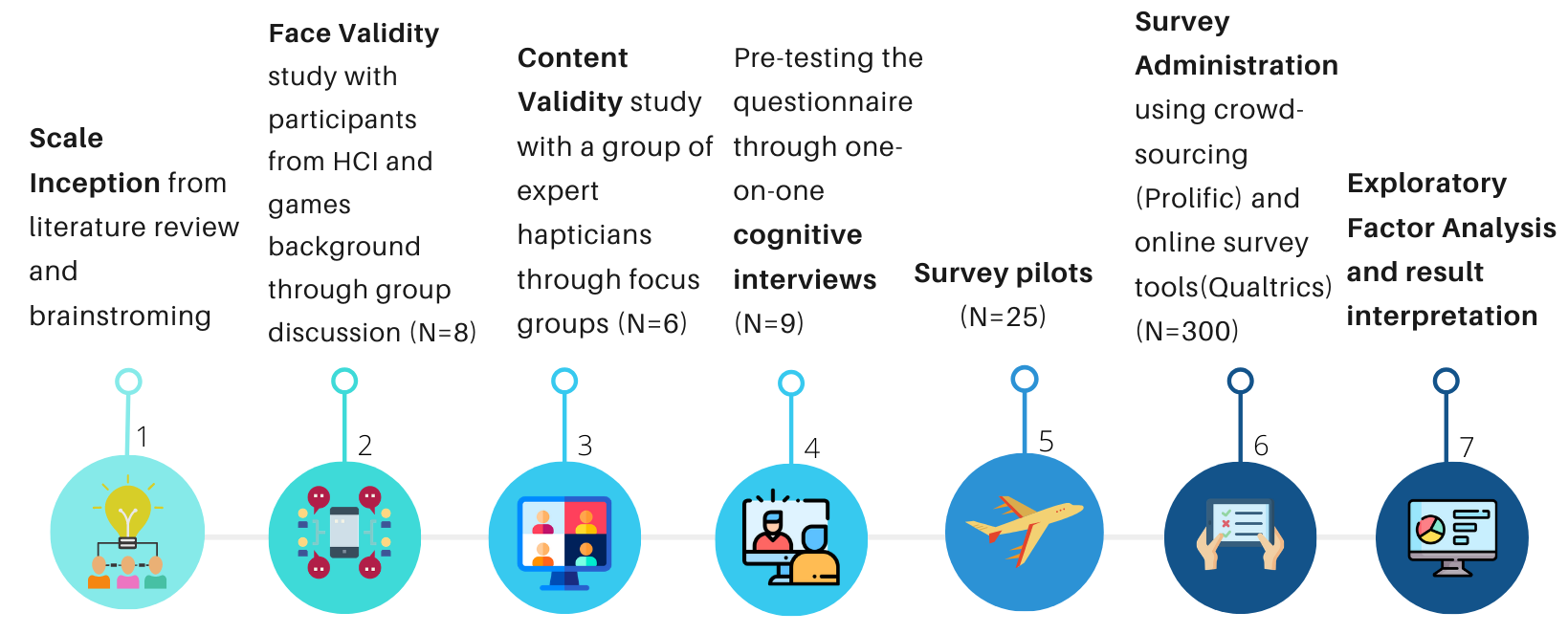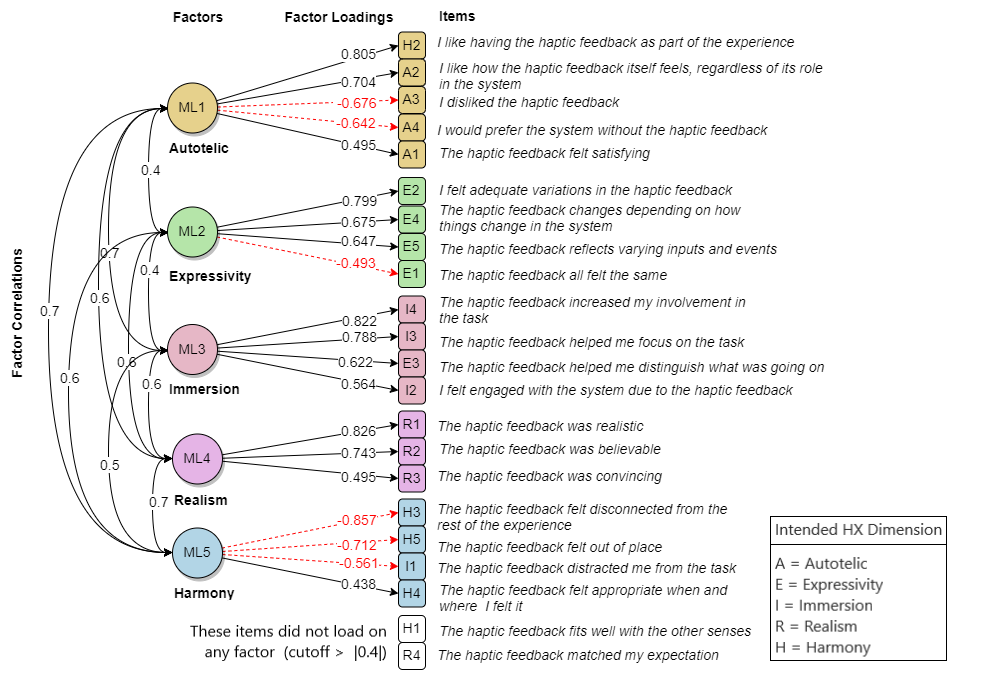We build upon the recent Haptic Experience (HX) model and report on progress towards measuring the five foundational constructs for designing haptic experiences.
Haptic technology is becoming an essential tool for designers seeking to create great user experience (UX). There is mounting evidence that haptic feedback of different types can contribute to existing UX measures. However, these metrics give little insight into how and why haptics contributes to peoples’ experience, and little direction for hapticians to improve their designs.
Currently, designers, researchers, and hapticians use qualitative methods to gain deeper insight into their designs. Practitioners favour small, in-person acceptance tests to evaluate their designs, iterating until it just “feels right,” and in-person demos to persuade stakeholders. Neither approach scales to large quantitative studies or translate to remote work, and while some hapticians employ general scales like the AttrakDiff questionnaire, there is still a desire for more targetted measurement tools.
In this paper, we report on initial findings from conducting scale development to measure haptic experience (HX). Scale development – designing and validating a measurement instrument – is considered critical to building theoretical knowledge in human and social sciences. We employed scale development to better understand the HX model, a proposed standard for defining haptic experience in terms of its pragmatic (usability) and hedonic (experiential) factors.
We conducted the first steps of scale development to assess how the HX model fits different devices and applications, understand user’s expectations and emotions, and analyze whether the HX model is supported by empirical evidence. Using the results of a series of 5 user studies and exploratory factor analysis (EFA), we developed an initial draft of a measurement instrument, and here report on the theoretical and practical findings.
We focused on vibrotactile devices to enable a remote study, but are actively expanding our findings with other devices. Please note that the questionnaire is still being developed, and not ready for deployment. We will provide instructions once we have a validated instrument.

Evidence for a 5-factor HX model
The results from EFA closely resemble the proposed theoretical HX model: the best-performing model had 5 factors, each of which closely relates to one HX factor. This suggests that the underlying factors of the HX model are distinct (though related) entities that can be measured, and was best modeled with 5 factors. While there might be concerns that this was a “re-discovery” of the 5 factors we used to design the items, best practices in scale development suggest starting with a strong theoretical basis.

Enriched description of the HX model’s constructs
Autotelic (feeling good itself): Autotelics turned out to be the strongest factor with maximum influence on its variables. The high factor loading of all the items is an indicator of how important it is to design a feedback that is likable and satisfying to the user from the sensation alone. While Autotelic by definition means that the feedback feels good in and by itself, the factor loadings indicate that the context of the system might significantly influence the likability of the feedback. These results suggest that, for an application to have a good autotelic experience, it necessarily requires context and cannot be considered in isolation.
Expressivity (variety of output): One item intended for expressivity (“The haptic feedback helped me distinguish what was going on”) loaded on Immersion instead of Expressivity, suggesting that Expressivity has more to do with variance of feedback than causality, and that feedback of someone’s actions is connected to Immersion. We thus suggest that Immersion “allows users to feel their input make an impact on the feedback received” [9], not Expressivity.
Immersion (being immersed in an environment): All positive items of Immersion loaded together, confirming our existing understanding of the dimension. We conclude that increased involvement, focus, and engagement is an indicator of an immersive experience. This lends support to the idea that when users can both affect and be affected by the system, they become more immersed in it (as described by the concept of Presence).
Realism (believable output): One interesting question raised during content validity discussion was about realism vs believability. Some of the experts argued that believability might be a construct of its own and some agreed that it is mostly an aspect of realism. Since R2 (“The haptic feedback was believable”) has a high factor loading of 0.743, we suggest that the factor “realism” and “believability” are closely linked, since “believability” varies with realism. However, we do not yet have enough information to suggest which might be primary. As “realistic” is a higher loading item compared to “believability” and since it’s consistent with the HX model, we decided to label this factor as “realism” - the debate continues.
Harmony (linked with system, other senses): Harmony was originally loaded with 3 negative items and 1 positive item. All the negative items were positively correlated with the factor and the positive one was negatively correlated. This factor was in fact the opposite of the construct Harmony. We decided to label this factor as harmony, since it simply appears to be dominated by “negative factors”, and can be interpreted with all signs flipped. In other words, Harmony might be detectable from the absence of a disruptive feedback. For example, if the haptic feedback does not feel “disconnected” from the system or “out of place,” it may be harmonious.
Practical guidelines for quantitatively measuring HX
1)
A
questionnaire
is
viable
for
measuring
HX:
We
repeatedly
debated
whether
a
questionnaire
was
the
right
choice
for
evaluating
HX.
Measuring
experience
is
difficult.
Focusing
on
a
particular
type
of
feedback
while
keeping
in
mind
the
overall
experience
is
even
more
challenging.
Through
brainstorming
and
reviewing
work
around
measurement
instruments,
we
were
convinced
that
a
well-designed
questionnaire
can
collect
systematic
data
of
user
emotions
and
expectations
about
a
system
or
design.
We
found
participants
typically
interacted
with
haptic
experience
for
5
minutes,
with
the
entire
task
and
questionnaire
taking
10
minutes.
This
suggests
that
participants
can
complete
a
20-question
instrument
in
less
than
5
minutes,
suitable
for
evaluating
systems
without
being
too
onerous
on
participants.
However,
approximately
12%
of
our
survey
participants
reported
that
they
did
not
feel
any
haptic
feedback
in
the
guided
task
and
their
responses
consisted
only
of
neutral
options.
Measurement
of
HX
may
only
be
applicable
for
applications
with
a
prominent
haptic
feedback
component,
or
when
participants
direct
their
attention
to
the
haptics.
2) “Haptic feedback” needs to be defined for general participants: We initially referred to the unit measured as “feedback”, in order to keep it generic and simple. However, “feedback” was ambiguous as participants were confused about what feedback we were referring to. We then decided to change it to “haptic feedback” based on the input from experts. This change could potentially make the question- naire difficult to comprehend for novice participants: 57.7% of our survey participants had not heard of the word or unsure of what it means. Thus, we included a simple definition of haptic feedback (as described in Results). We found that defining haptic feedback was necessary to help users understand the items from 82.9% of survey respondents.
3) Not all factors apply in all contexts: In order to build our studies around measuring haptics, we had to provide participants with applications that are experienced as a system, but also have recognizable haptic feedback. For example, watching a haptic ad - which is very similar to watching any video with sounds and visuals. We conducted an initial screening with smartwatches and fitness tracking devices and discovered that not all our constructs may apply to simpler applications, such as a timer or a “step goal reached” alert. Some applications don’t have a real-world equivalent, so “believability”, “realistic” and “convincing” seem irrelevant to the experience, or confusing; one participant interpreted “believable” as believing that the vibration came from their FitBit. Thus, any resulting questionnaire should ideally be designed with sub scales that can be selected depending on the needs of the researcher and the context of the study.